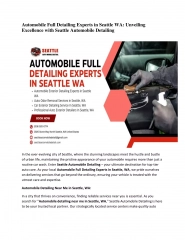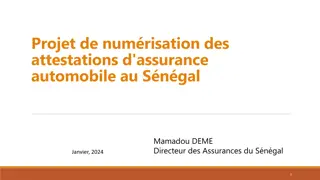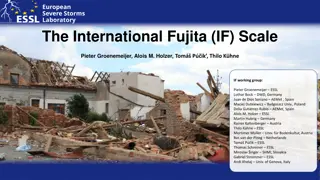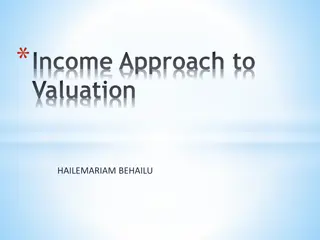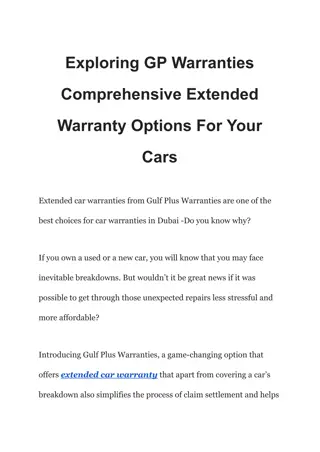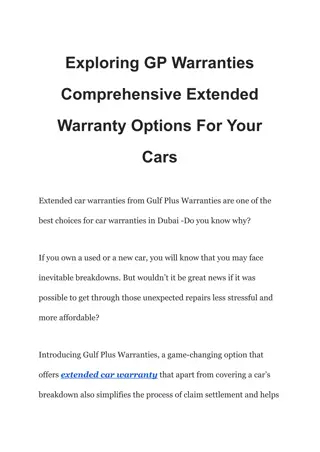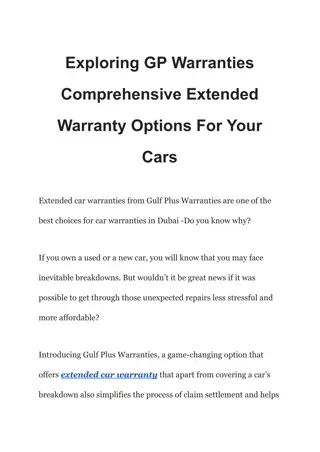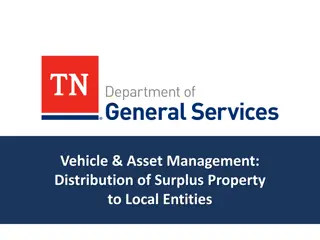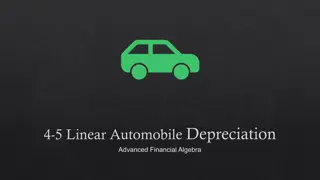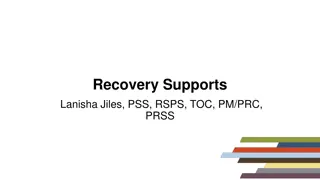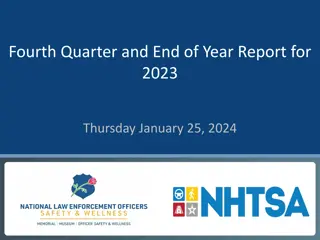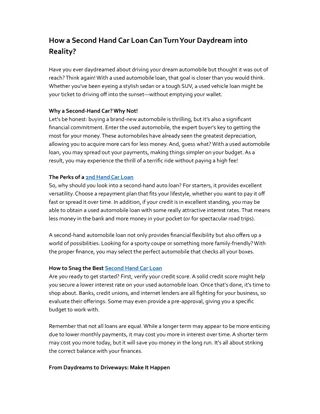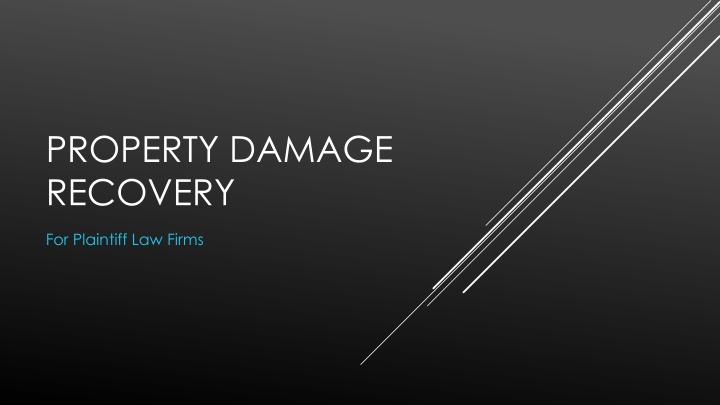
Increase Revenues with Property Damage Recovery Strategies
Learn how plaintiff law firms can enhance revenues and client satisfaction by recovering uncompensated property damages in existing auto BI cases. Explore topics like diminution in value, total loss, loss of use, and the Made Whole Doctrine.
Download Presentation

Please find below an Image/Link to download the presentation.
The content on the website is provided AS IS for your information and personal use only. It may not be sold, licensed, or shared on other websites without obtaining consent from the author. If you encounter any issues during the download, it is possible that the publisher has removed the file from their server.
You are allowed to download the files provided on this website for personal or commercial use, subject to the condition that they are used lawfully. All files are the property of their respective owners.
The content on the website is provided AS IS for your information and personal use only. It may not be sold, licensed, or shared on other websites without obtaining consent from the author.
E N D
Presentation Transcript
PROPERTY DAMAGE RECOVERY For Plaintiff Law Firms
COURSE SYNOPSIS How to increase revenues and client satisfaction on existing auto BI cases by recovering uncompensated property damages; Diminution in Value Total Loss Loss of Use Retrospectively not prospectively (Fees Earned). Without much added work or hassle. Using a well-tested successful process.
The Made Whole Doctrine The Release of Claim Collateral Source Rule Diminution in Value Total Losses Loss of Use The Automotive Technology Q & A Recovery Process AGENDA
As a rule, insurers do not require releases in the settlement of property damage claims, due to the cost. There is a strong argument that no claim is settled until a release has been executed. RELEASE OF CLAIM The documents executed for a total loss claim relate to the sale of the salvage and don t include a release. The failure to secure a release is arguably an act of bad faith on the part of the third-party insurer who has a duty to protect their insured. Most uncompensated property damage claims are ripe at BI demand.
In 1992, the Florida Supreme Court acknowledged the application of the Made Whole Doctrine stating: Using the common law subrogation principle, endorsed by Florida courts, the District Court reasoned that the insured was entitled to be made whole before the subrogated insurer could participate in the recovery from a tortfeasor. Insurance Co. of North Am. v. Lexow, 602 So.2d 528 (Fla. 1992); Florida Farm Bur. Ins. Co. v. Martin, 377 So.2d 827 (Fla. 1979). THE MADE WHOLE DOCTRINE Insurer s violate this as a standard practice but take corrective action when called out.
Section 768.76(1) In any action to which this part applies in which liability is admitted or is determined by the trier of fact and in which damages are awarded to compensate the claimant for losses sustained, the court shall reduce the amount of such award by the total of all amounts which have been paid for the benefit of the claimant, or which are otherwise available to the claimant, from all collateral sources; however, there shall be no reduction for collateral sources for which a subrogation or reimbursement right exists. Such reduction shall be offset to the extent of any amount which has been paid, contributed, or forfeited by, or on behalf of, the claimant or members of the claimant's immediate family to secure her or his right to any collateral source benefit which the claimant is receiving as a result of her or his injury. THE COLLATERAL SOURCE RULE
The Restatement of Torts 928 provides, in pertinent part, as follows: Where a person is entitled to a judgment for harm to chattels not amounting to a total destruction in value, the damages include compensation for: (a) the difference between the value of the chattel before the harm and the value after the harm, or at the plaintiff s election, the reasonable cost of repairs or restoration where feasible, with due allowance for any difference between the original value and the value after repairs. DIMINUTION IN VALUE LAW
Owned as opposed to leased, even if financed. In good original condition with no prior accidents. DIMINUTION IN VALUE CASE CRITERIA Structural damage was incurred, e.g., Unibody/Frame. Very new and/or expensive vehicles without structural damages can be good claim candidates.
STRUCTURAL DAMAGE
Even minor collisions have the potential to cause distortion to the Unibody. Unibody tolerances are too small to be discerned by the human eye, thus Laser Measuring is employed for diagnosing damage. Insurance companies actively discourage body shops from measuring for Unibody damage because they d prefer not to find it. UNIBODY FACTS One of the biggest lies you ll here is that the shop didn t need to Setup & Measure the Unibody because no damage was visible. Most body shops are controlled by the insurance industry.
A vehicles structural integrity can never be fully restored. Structural damage must be disclosed upon conveyance. Failure to disclose can lead to the reversal of a sales transaction. WHY ARE REPAIRED VEHICLES WORTH LESS? If someone were to be hurt in an accident related to the undisclosed structural damage, the consequences could be much more severe. New car dealers will not place structurally repaired vehicles into their used car inventory. Dealers sell such vehicles at auction under a red light, with full disclosure to ensure the sale is final.
Body shop repairs are no match for factory assembly processes. Body shop paint cannot be cured to original factory specifications. Manufacturer warrantees do not apply to collision related failures and/or aftermarket parts. WHY ARE REPAIRED VEHICLES WORTH LESS? The following guaranties expire upon conveyance of the vehicle. Body Shop Insurance company Aftermarket Part Suppliers The buyer of a collision repaired vehicle is on their own as to future problems, thus may look to the seller.
MEASURING DIV Assuming the case selection criteria was followed, the pre- accident value is Clean Retail . Assuming the Unibody was compromised, the post auction value is Low Auction . The DIV in this instance was nearly $7,000
Most insurers utilize specialty third-party vendors for total loss evaluations that are not recognized by the rest of automotive industry. Insurers pick apart the condition of your client s vehicle and then discern its value based on uninspected comparable vehicles, assuming them to be in pristine condition. By comparing the insurer s offer to NADA an expert can quickly assess the amount that the claim was undervalued. TOTAL LOSSES If the difference is enough, your client may want to authorize an opinion and recovery. Whether the 1st or 3rd-party insurer paid the claim, the tortfeasor is ultimately responsible for the underpayment, although 1st-party insurers can be sued for breach of contract. An expert opinion of the underpayment based on NADA provides compelling evidence, while an insurer would struggle to justify their valuation.
LOSS OF USE MEAKIN V. DREIER, 209 SO. 2D 252 (1968)
Almost every auto BI case you handle has a potential LOU or excess LOU claim. LOU is often an add-on claim to DIV or total losses. Even where a client is provided with a rental by their 1st or the 3rd-party insurer, there is often an excess LOU claim. First party rental reimbursement coverage is limited as to the daily rate and number of days. LOSS OF USE Both 1st and 3rd-party insurers often terminate rentals prematurely and/or provide less than a comparable vehicle. Where the client does not carry 1st-party rental coverage, they are entitled to the collision waiver and when a 3rd- party carrier doesn t accept liability immediately, that also counts as compensable downtime. An expert opinion as to the reasonable period and the cost of a comparable rental ensures the damages are presented accurately.
Augment your fee agreement to include PD on the same terms. Upon preparing for a BI demand, email PD documents to your expert, e.g., repair appraisal or total loss valuation and rental invoice. Your expert should be willing to provide you with a free preliminary estimate of any uncompensated PD damages. THE PROCESS If case is cost effective and you are willing to suit it if necessary, the client may want to authorize the expenditure for an opinion. Attach the opinion to your BI demand and include the amount of the damages in your demand letter.
You are unlikely to settle the PD ahead of the BI. Insurers usually assign a separate adjuster to handle the PD. Don t discuss these cases with adjusters, ask for everything in writing. Insufficient BI limits creates settlement leverage for the PD because failing to resolve the PD claim could expose the tortfeasor s assets. SETTLEMENT STRATEGIES If you know you are going to have to suit the BI, PD can be included at no extra cost and defense attorneys are much easier on PD claims. BI adjusters are typically happy to settle the BI without releasing the PD, opening the door to the Proposal for Settlement strategy.
Once a case becomes PD only you can file a PFS 90 days post suit. The idea is to tread water in terms of suit activity until the PFS is filed. Your expert can provide you with a PFS number likely to produce a +25% judgment, resulting in an award of legal fees and costs. PROPOSAL FOR SETTLEMENT Insurance companies are jumping on PFS s every time and almost immediately. A case should have a PFS value of at least $2,500, to be economically feasible unless you must suit the BI.
Demand Offer 4,500 $ 1,000 $ Take Offer Settlement 1,000 $ $ $ PFS 125% Judgment 3,999 $ Settlement 3,199 $ 1,056 $ $ $ 1,243 $ Gross S/A Contingency Opinion Filing Fee Net Settlement 333 400 33% 40% PFS 3,199 $ 400 500 $ 400 $ 267 $ 3,599 PROPOSAL FOR SETTLEMENT
Nearly every auto BI case has an underpaid PD component, the question is how much? You can get the answer to how much for free. If you only order opinions where it is cost effective to do so, you will be successful again and again. TAKE A WAYS The process minimizes work on your end. Your clients don t know they can get another shot at the PD, so they depend on you to advise them. Don t release PD with the BI settlement without vetting the PD.

